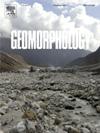Quantifying coastal cliff retreat, sediment volume, and dynamics using photogrammetry and geospatial analysis in the Pénestin Peninsula, France
IF 3.1
2区 地球科学
Q2 GEOGRAPHY, PHYSICAL
引用次数: 0
Abstract
Recently, rocky cliffs globally have garnered immense attention due to their susceptibility to erosion, collapse, and instability, similar to the frequent monitoring of low-lying coastal zones for risks associated with climate change-related sea-level rise and flooding. Historically, sediment volumes have been extensively studied and constrained; however, recent advancements in remote sensing and UAV technology now facilitate more precise quantitative assessments of the volumes of sediment loads involved in these transfers. In this study, we analyse erosion and sediment transport in two sectors of the Pénestin Peninsula in South Brittany using high-resolution and high-frequency drone imagery. We integrate an array of geospatial datasets to perform a detailed photogrammetric analysis of approximately 900 m of the Mine d'Or cliff. The resulting topographic and morphological differentials at the land-sea interface reveal significant erosional asymmetry between the southern and northern sectors of the beach, primarily influenced by gravitational forces and urban development at beach access points. Quantitatively, since 1952, the southern sector has experienced a higher average annual retreat compared to the northern slope. Our mapping of the dynamics of coarse and medium sand stocks along the northern coast of the peninsula, spanning the period from 2010 to 2020, indicates that approximately 32,000 m3 of material from cliff erosion has contributed to the sediment accumulation on the shore, particularly within the Branzais Marsh. Furthermore, while 10,000 m3 were removed from the beach due to littoral drift transport, approximately 12,000 m3 of sand and gravel were revealed to be in transit to the northern coast. This quantitative analysis underscores the substantial impact of rocky coastal cliff erosion as a major sedimentary source in a context of limited external sediment supply. The sediment stock, made available for transit and deposition due to local hydrodynamic factors, is notably influenced by a northward longshore drift.
使用摄影测量和地理空间分析在法国psamenestin半岛量化海岸悬崖退缩、沉积物体积和动态
最近,全球的岩石悬崖因其易受侵蚀、崩塌和不稳定的影响而引起了极大的关注,类似于对低洼沿海地区频繁监测与气候变化相关的海平面上升和洪水相关的风险。从历史上看,沉积物体积已经被广泛研究和限制;然而,最近遥感和无人机技术的进步现在促进了对这些转移中涉及的沉积物负荷体积的更精确的定量评估。在这项研究中,我们使用高分辨率和高频无人机图像分析了南布列塔尼psamnestin半岛两个部门的侵蚀和沉积物运输。我们整合了一系列地理空间数据集,对大约900米的Mine d'Or悬崖进行了详细的摄影测量分析。陆海界面的地形和形态差异揭示了海滩南北段之间明显的侵蚀不对称性,主要受海滩接入点的重力和城市发展的影响。从数量上看,自1952年以来,南段的年平均退缩量高于北坡。我们绘制了2010年至2020年期间半岛北部海岸粗砂和中砂储量的动态图,表明大约32,000立方米的悬崖侵蚀物质导致了海岸上的沉积物堆积,特别是在Branzais沼泽内。此外,虽然由于沿海漂流运输从海滩移走了10,000立方米,但大约12,000立方米的沙子和砾石被发现正在运往北部海岸。这种定量分析强调了在外部沉积物供应有限的情况下,岩质海岸悬崖侵蚀作为主要沉积来源的重大影响。由于当地的水动力因素,泥沙存量可用于搬运和沉积,并受到向北的海岸漂移的显著影响。
本文章由计算机程序翻译,如有差异,请以英文原文为准。
求助全文
约1分钟内获得全文
求助全文
来源期刊

Geomorphology
地学-地球科学综合
CiteScore
8.00
自引率
10.30%
发文量
309
审稿时长
3.4 months
期刊介绍:
Our journal''s scope includes geomorphic themes of: tectonics and regional structure; glacial processes and landforms; fluvial sequences, Quaternary environmental change and dating; fluvial processes and landforms; mass movement, slopes and periglacial processes; hillslopes and soil erosion; weathering, karst and soils; aeolian processes and landforms, coastal dunes and arid environments; coastal and marine processes, estuaries and lakes; modelling, theoretical and quantitative geomorphology; DEM, GIS and remote sensing methods and applications; hazards, applied and planetary geomorphology; and volcanics.
 求助内容:
求助内容: 应助结果提醒方式:
应助结果提醒方式:


